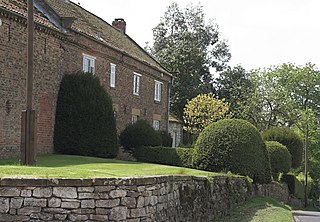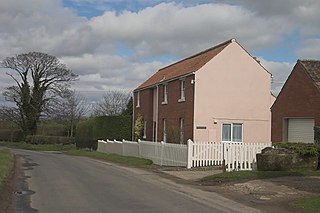
Kirkham is a village in the civil parish of Westow, in North Yorkshire, England, close to Malton, situated in the Howardian Hills alongside the River Derwent, and is notable for the nearby ruins of Kirkham Priory, an Augustinian establishment.

Barugh (Great and Little) is a civil parish in North Yorkshire, England, covering Great Barugh and Little Barugh. Great Barugh is located at a junction on the road between Malton and Kirkbymoorside. Barugh is about 15 miles (24 km) west of Scarborough.

Byland with Wass is a civil parish in the former Ryedale district of North Yorkshire, England. According to the 2001 census it had a population of 120, increasing to an estimated 160 in 2015. It covers Byland Abbey and Wass, in the North York Moors, and shares a parish council with Oldstead.

Yearsley is a small village and civil parish in the district of Hambleton in North Yorkshire, England. The population of the civil parish was less than 100 at the 2011 Census. Details are included in the civil parish of Brandsby-cum-Stearsby. It is situated between the market towns of Easingwold and Helmsley.
Kirby Misperton is a small village and civil parish in North Yorkshire, England and has a population of around 370.

Oswaldkirk is a small village and civil parish 4 miles (6.4 km) south of Helmsley and 20 miles (32 km) north of York in North Yorkshire, England. It is named after the village church of St Oswald, King and Martyr, the Anglo-Saxon King of Northumbria who was slain by the pagan, Penda in 642. There was previously a Catholic church, dedicated to St Aidan, which closed in 2020. The population of the village as taken at the 2011 census was 230.

Wass is a village in the civil parish of Byland with Wass, in North Yorkshire, England, in the North York Moors National Park. A short distance from the village lie the ruins of Byland Abbey. Despite the small size of the village there is a pub, the Stapylton Arms. It is at the foot of Wass Bank and has views of the surrounding countryside. From 1974 to 2023 it was in the Ryedale district.

Bransdale is a valley running south through North Yorkshire, England, and part of the North York Moors National Park. Sandwiched between Bilsdale to the west and Farndale to the east, it is formed from the dales of Bransdale itself at the top of the valley, Sleightholmedale and Kirkdale. It carries a river called Hodge Beck en route from Cockayne to the River Dove from Farndale three miles (4.8 km) of Kirkbymoorside, which runs on into the Vale of Pickering and the River Rye.

Timble is a village in the Harrogate district of North Yorkshire, England. It is situated on the slopes of the Washburn valley, north of Otley and close to Swinsty and Fewston reservoirs.

Normanby is a village and civil parish in the Ryedale district of North Yorkshire, England. It is about 4 miles (6.4 km) west of Pickering. It lies on the main road between Malton and Kirkbymoorside.

East Knapton is a village in the civil parish of Scampston, in North Yorkshire, England. Until 1974 the village lay in the historic county boundaries of the East Riding of Yorkshire. From 1974 to 2023 it was a part of the Ryedale district.
Swinton is a village and civil parish in North Yorkshire, England. It is about 2 miles (3.2 km) west of Malton on the B1257 road, and is on the edge of the Howardian Hills AONB to the immediate north. The village appears in the Domesday Book as 'Swintune' which is derived from 'pig farm'.
Hildenley is a former civil parish 2 miles (3.2 km) south-west of Malton, North Yorkshire, England, on the north bank of the River Derwent. In 1961 the parish had a population of 17. Hildenley stone, considered to be the best decorative stone in Yorkshire, takes its name from the site.

Wath is a small hamlet in the civil parish of Hovingham, in North Yorkshire, England. It is situated at the northern edge of the Howardian Hills AONB, about 0.6 miles (1 km) east of Hovingham on the B1257 road which crosses here over Wath Beck. Limestone is quarried here which in the 1950s was in demand by the steel industry for lining the furnaces.

Ryton is a hamlet and former civil parish 19 miles (31 km) from York, now in the parish of Habton, in the Ryedale district, in the county of North Yorkshire, England. In 1961 the parish had a population of 124.

Butterwick is a village and former civil parish about 6 miles from Pickering, now in the parish of Barton-le-Street, in North Yorkshire, England. In 1961 the parish had a population of 41. Butterwick has a church called Holy Epiphany.

Great Habton is a village and former civil parish about 18 miles from York, now in the parish of Habton, in the Ryedale district, in the county of North Yorkshire, England. In 1961 the parish had a population of 103.

South Holme is a settlement and civil parish about 17 miles from York, in the Ryedale district, in the county of North Yorkshire, England. In 2001 the parish had a population of 31. The parish touches Barton-le-Street, Fryton, Hovingham, Nunnington and Slingsby. South Holme shares a parish council with Slingsby and Fryton.

Little Habton is a hamlet and former civil parish, now currently in the parish of Habton, in the Ryedale district of North Yorkshire, England. In 1961, it had a population of 59.

Menethorpe is a hamlet and former civil parish, now in the parish of Burythorpe, in North Yorkshire, England. In 1931 the parish had a population of 68. It is about 2.5 miles (4 km) from Malton.


















